Sleek yet striking, Dobermans turn heads with their glossy coats and rustic markings. But did you know they come in colors beyond the signature black and tan? Take a walk through the vibrant world of Doberman hues. Learn how genes determine if your Doberman dons a chocolate coat or albino aesthetic. Discover the health implications of rare white and blue shades. We’ll debunk controversies around breeding albino Dobies. You’ll also see how color affects pricing and breed standards for these intelligent dogs. From examining the genetics behind their pigmentation to appreciating the visual delight of multi-colored Dobies, this comprehensive guide will make you view Doberman coats in a whole new light!
Table of Contents
- 1 Delving into Common Doberman Color Variations
- 2 Insights on Rare Doberman Coat Colors
- 3 The Uniqueness of Albino Dobermans
- 4 Exploring Nonstandard Doberman Breed Standards
- 5 Impact of Doberman Colors on Cost
- 6 Wrapping Up on Doberman Color Diversity
- 6.1 Does the color of a Doberman impact its temperament?
- 6.2 Are certain colors of Dobermans more expensive than others?
- 6.3 Is there any health issue associated with different colored Dobermans?
- 6.4 Are albino Dobermans accepted in dog shows?
- 6.5 Does the coat color change as the dog ages?
- 6.6 What is the most popular color for a Doberman?
- 6.7
- 7 Related posts:
- 8 Ultimate Guide to Raising a Healthy Doberman Puppy
- 9 Doberman Temperament Traits & Facts
- 10 Doberman Pinschers (26 Loyal Dogs)
- 11 Cracking the Code: Taming Doberman Aggression
Delving into Common Doberman Color Variations
Dobermans, a popular dog breed, exhibit various colors. The most common color is the striking combination of black and rust. This standard color gives them their iconic look – a sleek black coat with rust-colored markings that highlight their muscular physique.
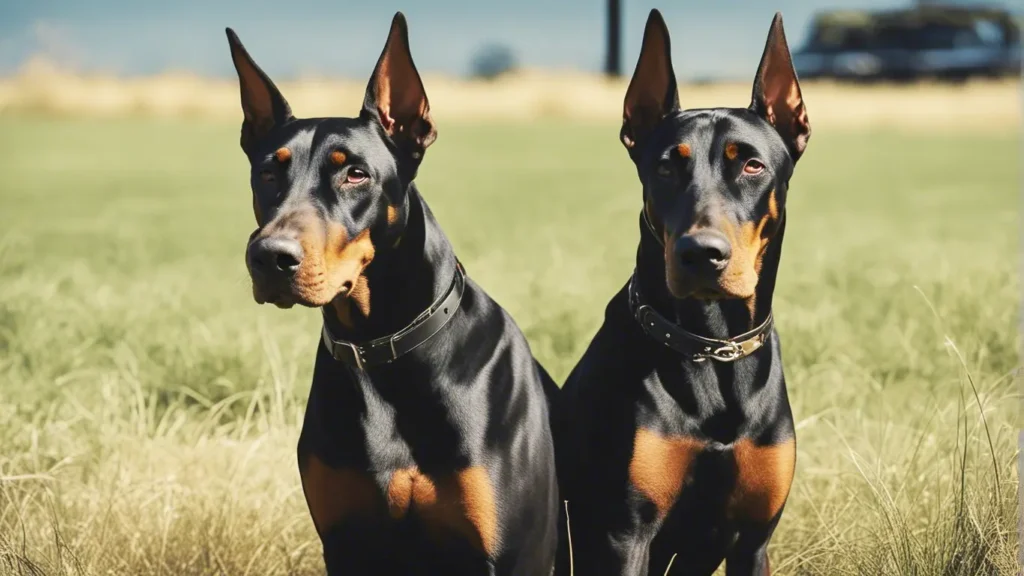
Other Typical Hues
Beyond the standard black and rust, Dobermans come in different colors:
- Red: A rich, light brown or red male Doberman can be quite stunning.
- Blue: This isn’t your typical blue. It’s more of a melanistic blue, akin to a colored tiger in the dog world.
- Fawn: A diluted version of the red, creating a light tan or fawn color.
Genes determine all these colors. Specifically, the color dilution gene plays a significant role in these variations.
Genes and Colors
The interplay between genes results in this array of hues. For instance:
- The melanistic coloration results from dominant genes.
- The white color is due to recessive genes.
- The blue color and fawn are due to the influence of the color dilution gene.
These genetic combinations result in unique colored markings that set each Doberman apart from its peers while maintaining commonalities within the breed.
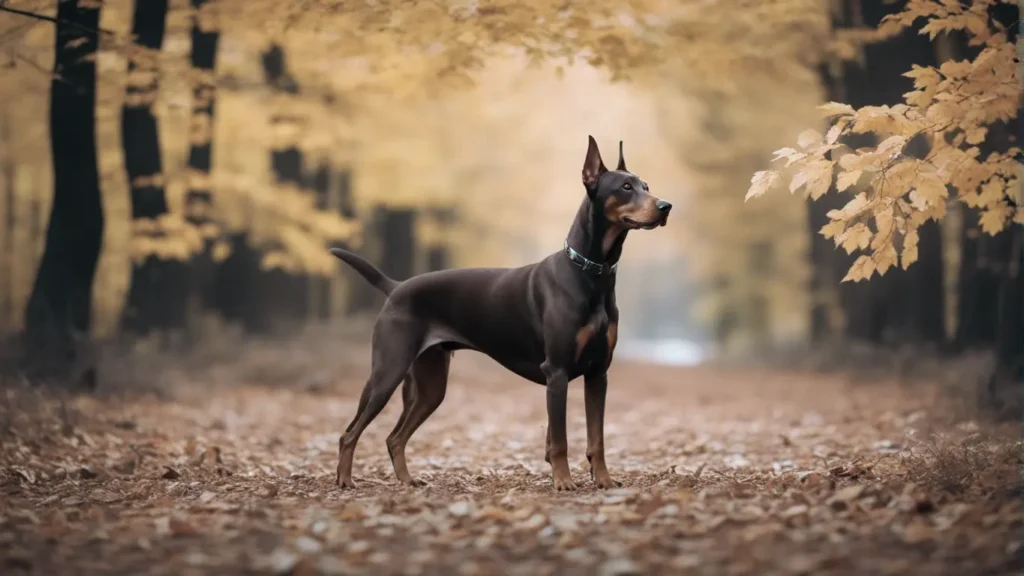
Impact on Appearance
The impact of these colors on a Doberman’s appearance is profound:
- Black and rust give an intimidating yet regal look.
- Red exudes warmth and vibrancy.
- Blue provides an unusual yet captivating aesthetic appeal.
- Fawn offers an elegant subtlety.
Despite being bred for functionality over aesthetics, there’s no denying that these colors contribute significantly to making Dobermans one of the most visually distinctive breeds out there!
Insights on Rare Doberman Coat Colors
Unusual White and Cream Coats
White or cream-colored coats in Dobermans are a sight to behold. These rare colors, although striking, are less common than the standard black coat or red hair. They’re a result of unique genetic mutations.
Chocolate or Isabella Dobies
Even more scarce are chocolate or Isabella-colored Dobies. These dogs sport a rust coat that is truly distinct but also extremely rare.
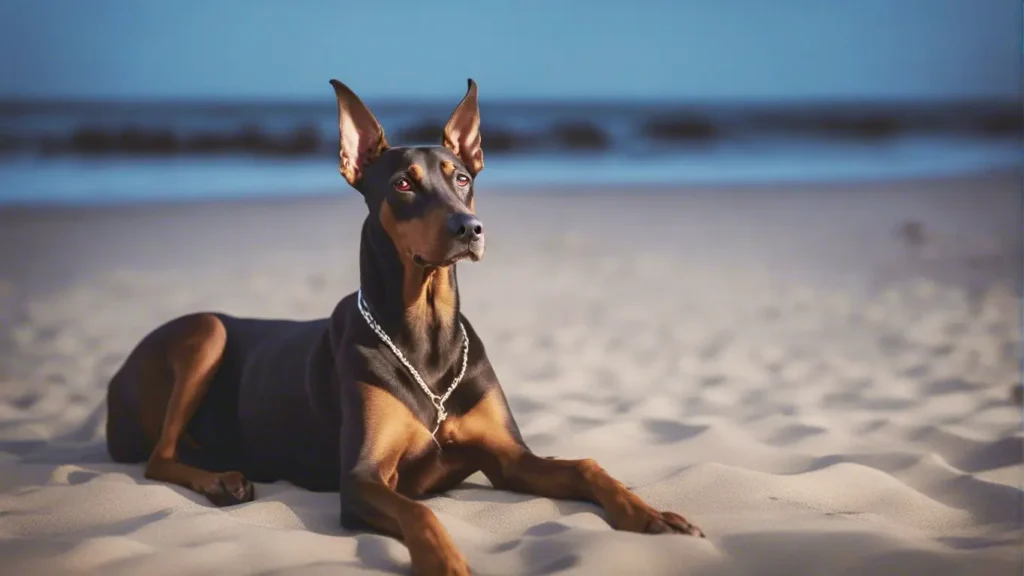
The Role of Dilution Gene
The dilution gene plays a crucial role in creating these unusual hues. It affects pigmentation, leading to lighter and sometimes unexpected coat colors.
- White
- Cream
- Chocolate
- Isabella
These are rare colors and proof of the fascinating genetic diversity within the breed.
Health Concerns Linked to Rare Colors
However, it’s important to note that specific health concerns correlate with these rare colors:
- Skin problems: Lighter-coated Dobermans often have sensitive skin.
- Eye issues: Dogs with unusually colored coats may be prone to eye conditions.
- Deafness: Some white and cream-colored Dobermans can have hearing issues.
So, while these rare shades might make your dog stand out at the park, they could also mean extra vet visits. Consider this if you’re considering adopting a Doberman with a nonstandard coat color.
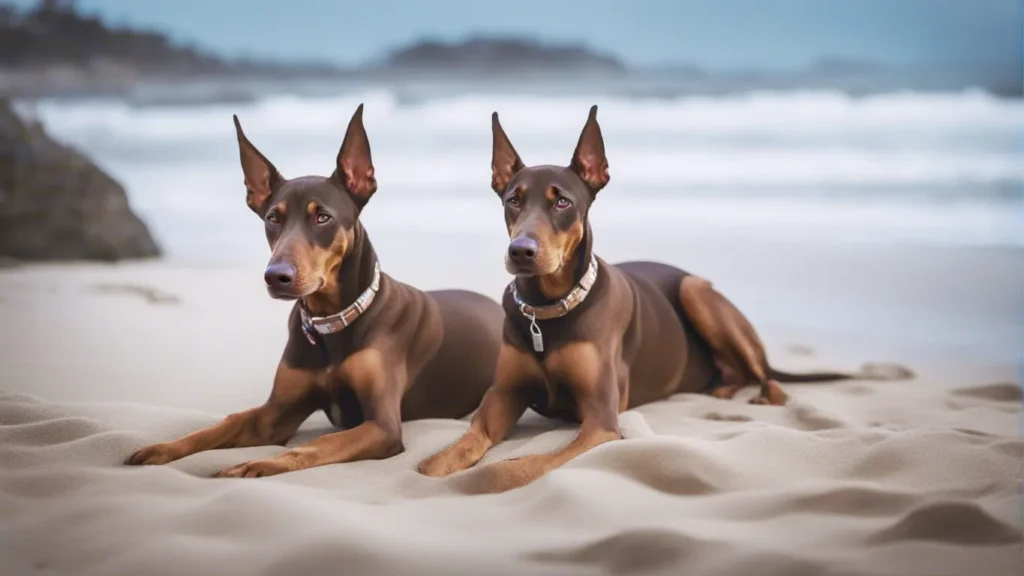
The Uniqueness of Albino Dobermans
Albinism, a condition often misunderstood in dogs, is particularly unique in Dobermans. Unlike white-coated breeds, true albino Dobermans lack pigmentation entirely. It’s not about having a light coat; it’s about the absence of color in skin, hair, and eyes.
Albino vs White-coated Dogs
- White dog: A regular white dog has normal pigmentation levels but carries genes for a white coat.
- True Albino: Full albinos lack melanin—the pigment responsible for color—in their skin, hair, and eyes.
This distinction isn’t just cosmetic. Albinism brings health challenges to Dobies:
- Increased sensitivity to sunlight due to lack of melanin
- Higher risk of sunburns and skin cancers
- Vision problems like photophobia (light sensitivity)
In contrast, melanistic black Dobermans or other colored breeds don’t face these issues.

Controversy Surrounding Albino Breeding
Breeding practices for albino Dobies stir controversy among purebred dog lovers:
- Some argue that breeding specifically for albinism is unethical because it predisposes the puppies to health issues.
- Others maintain that all dogs—including albinos—deserve love and care regardless of their color.
It’s crucial to remember that every Doberman—be it an albino or a standard black dober—is more than its coat color. They’re intelligent, loyal companions who deserve responsible breeding practices prioritizing health over aesthetics.
Just as you wouldn’t breed albino rabbits without considering potential health implications, the same caution should apply when breeding albino dogs.
So next time you see an unusual-looking white Doberman at the shelter or with intact dogs at the park, remember: they might be one of those rare full or partial albinos needing extra care and attention due to their unique genetic makeup!
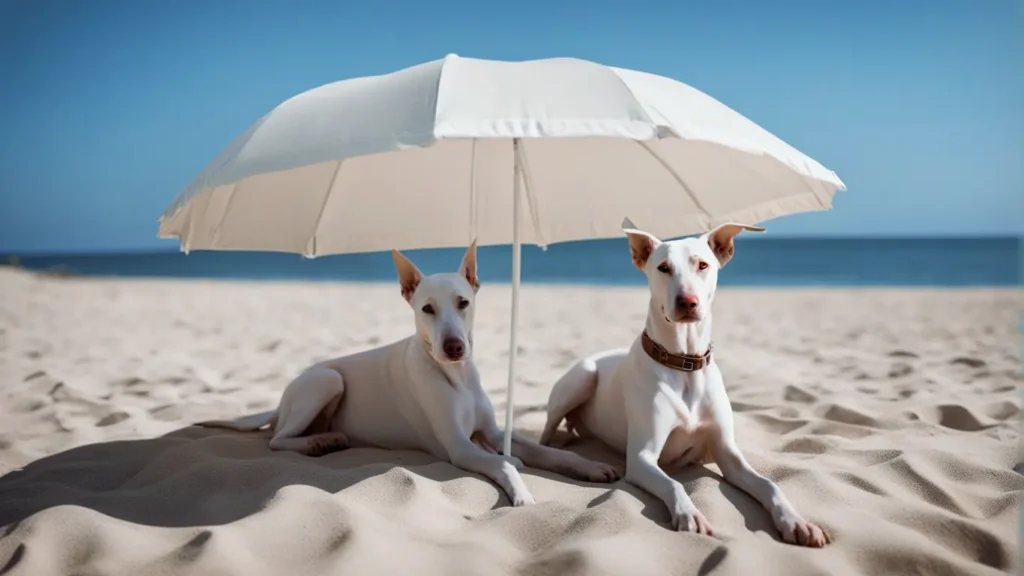
Exploring Nonstandard Doberman Breed Standards
Nonstandard and Breed Standards
Nonstandard Doberman colors aren’t aligned with the breed standard. Responsible breeders strive to maintain these standards for healthy dogs. But what’s nonstandard? It’s any color outside the usual black, red, blue, or fawn.
Kennel clubs worldwide have varying views on these nonstandard colors. Some accept them; others reject outright. A quick search can reveal a kennel club’s stance.
Ethical Concerns and Breeding
Breeding for nonstandard colors raises ethical issues. It can lead to behavioral issues and health concerns in Dobies:
- Dilution alopecia
- Color dilution hair loss
- Skin sensitivity
Responsible breeders prioritize the dog’s health over aesthetics.
Health Risks of Nonstandard Colors
Research shows that nonstandard colored Dobies may face more health issues than their standard counterparts. For instance, they might be predisposed to certain conditions such as hip dysplasia or eye problems.
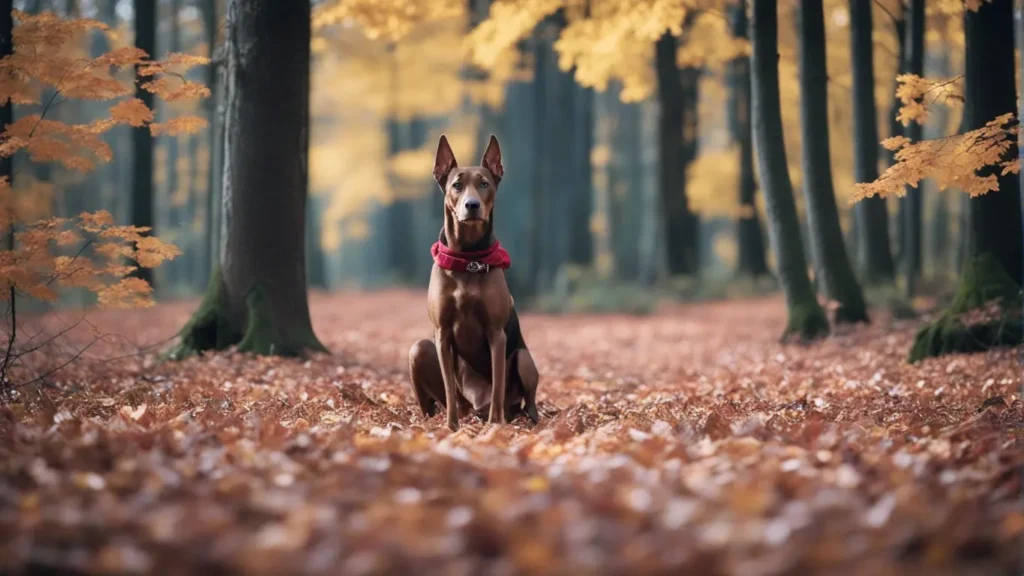
Before you try adopting a Doberman of a nonstandard color, test its health status first. Use this step to ensure you’re getting a healthy pet and not inviting avoidable heartache into your home.
Impact of Doberman Colors on Cost
Rarity and Price Tag
Doberman colors can significantly affect their price tag. For instance, the less common colors like blue or fawn Dobies are often expensive due to their rarity.
Demand and Popular Shades
The cost is also influenced by demand. Black & rust or red & rust Dobies are among the most sought-after shades, often commanding higher prices.
Breeder Pricing Differences
The breeder’s reputation plays a role as well:
- Ethical breeders tend to charge more for pups of any color, given their adherence to health testing and quality breeding standards.
- Backyard breeders may offer lower prices but often compromise on health testing results and color quality.
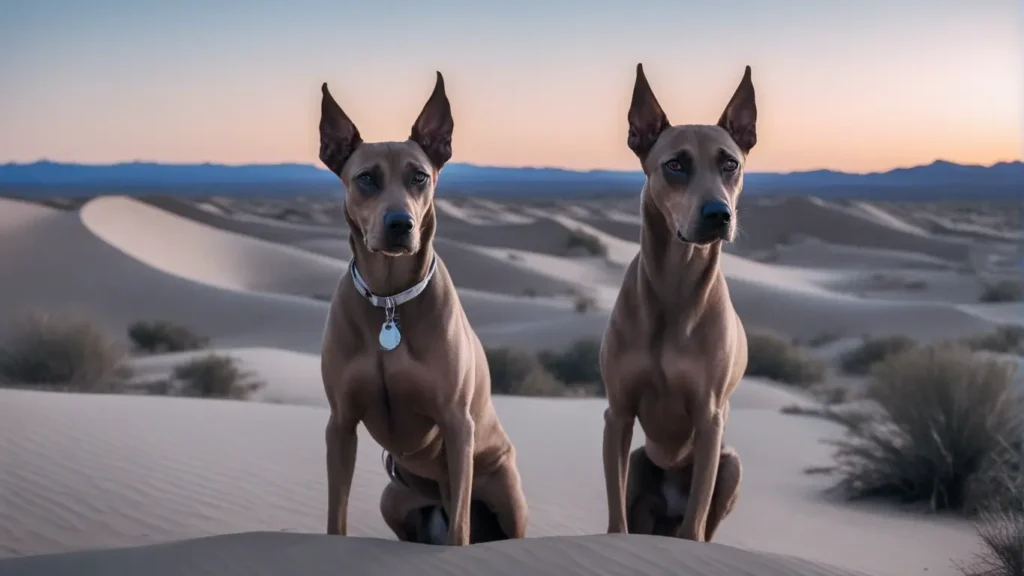
Health Costs Considerations
Certain coat colors in Dobermans are tied to specific health issues. For example, white or albino Dobies might suffer from photosensitivity or skin cancer, increasing long-term healthcare costs. So, while these pups might be cheaper upfront, owners should consider potential future vet bills when choosing a pup based on its color.
Wrapping Up on Doberman Color Diversity
In the spectrum of Doberman coats, aesthetics and ethics go hand-in-hand. Understand the health risks associated with specific colors. Seek reputable breeders who prioritize canine welfare over winning shows. Provide extra sun protection and vet care for light-coated dogs. Follow these tips, and your Doberman’s dazzling coat will be more than just a pretty exterior – it’s a sign of their inner well-being. Next time you admire a Doberman, look beyond color and see the faithful companion ready to brighten your life in any shade.
Does the color of a Doberman impact its temperament?
No, the color of a Doberman does not influence its temperament. The dog’s behavior is more determined by genetics, upbringing, and training.
Are certain colors of Dobermans more expensive than others?
Yes, some rare colors such as white or blue may be priced higher due to their rarity.
Is there any health issue associated with different colored Dobermans?
Certain coat colors may be linked to specific health issues. For instance, blue and fawn Dobies can suffer from Color Dilution Alopecia (CDA), a condition causing hair loss.
Are albino Dobermans accepted in dog shows?
Albino or white-colored Dobermans are considered nonstandard by many kennel clubs and often are not allowed in conformation shows.
Does the coat color change as the dog ages?
Dobermans’ coat can lighten or darken slightly as they age, but significant changes are unlikely.
What is the most popular color for a Doberman?
The most popular and commonly recognized color for a Doberman is black with rust markings.